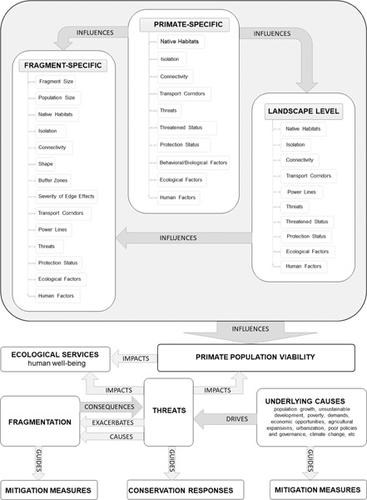当前位置:
X-MOL 学术
›
Am. J. Primatol.
›
论文详情
Our official English website, www.x-mol.net, welcomes your feedback! (Note: you will need to create a separate account there.)
Asian primates in fragments: Understanding causes and consequences of fragmentation, and predicting primate population viability.
American Journal of Primatology ( IF 2.4 ) Pub Date : 2019-12-24 , DOI: 10.1002/ajp.23082 Ramesh Boonratana 1
American Journal of Primatology ( IF 2.4 ) Pub Date : 2019-12-24 , DOI: 10.1002/ajp.23082 Ramesh Boonratana 1
Affiliation

|
Ongoing efforts to conserve the Asian primates are severely challenged by increasing rates of habitat loss and fragmentation. Underlying drivers such as rapid economic and population growth throughout much of South, East, and Southeast Asia have confined several populations of Asian primates to isolated fragments. Conservation efforts for these primates are partly hampered by a poor understanding of fragmentation, resulting in an inability to draw up effective long-term conservation responses. In this manuscript, I show that fragmentation can be understood better when treated both as stress and a threat. Moreover, despite a myriad of causes of fragmentation reported, most are broad descriptions or subject to various interpretations. Here I describe the use of the IUCN-CMP Unified Classifications of Direct Threats Version 3.2, a convenient and universal tool, for more precise identification of the causes and consequences of fragmentation for Asian primates. I further describe the interrelated variables influencing the persistence of Asian primates in fragments, and the conditions affecting these variables.
中文翻译:

亚洲灵长类动物的碎片化:了解碎片化的原因和后果,并预测灵长类种群的生存能力。
栖息地丧失和破碎化的速度越来越快,对保护亚洲灵长类动物的持续努力提出了严峻挑战。诸如南亚,东亚和东南亚大部分地区的快速经济和人口增长之类的潜在动因,将亚洲灵长类动物的若干种群限制在孤立的碎片中。对灵长类动物的保护工作由于对碎片的了解不足而受到部分阻碍,导致无法制定有效的长期保护措施。在这份手稿中,我表明将碎片当作压力和威胁都可以更好地理解。此外,尽管报告了多种导致碎片的原因,但大多数都是宽泛的描述或受到各种解释。在这里,我描述了IUCN-CMP统一威胁直接分类版本3.2的使用,一种方便且通用的工具,用于更精确地识别亚洲灵长类动物支离破碎的原因和后果。我进一步描述了影响亚洲灵长类动物在碎片中持续存在的相关变量,以及影响这些变量的条件。
更新日期:2020-04-13
中文翻译:

亚洲灵长类动物的碎片化:了解碎片化的原因和后果,并预测灵长类种群的生存能力。
栖息地丧失和破碎化的速度越来越快,对保护亚洲灵长类动物的持续努力提出了严峻挑战。诸如南亚,东亚和东南亚大部分地区的快速经济和人口增长之类的潜在动因,将亚洲灵长类动物的若干种群限制在孤立的碎片中。对灵长类动物的保护工作由于对碎片的了解不足而受到部分阻碍,导致无法制定有效的长期保护措施。在这份手稿中,我表明将碎片当作压力和威胁都可以更好地理解。此外,尽管报告了多种导致碎片的原因,但大多数都是宽泛的描述或受到各种解释。在这里,我描述了IUCN-CMP统一威胁直接分类版本3.2的使用,一种方便且通用的工具,用于更精确地识别亚洲灵长类动物支离破碎的原因和后果。我进一步描述了影响亚洲灵长类动物在碎片中持续存在的相关变量,以及影响这些变量的条件。



























 京公网安备 11010802027423号
京公网安备 11010802027423号